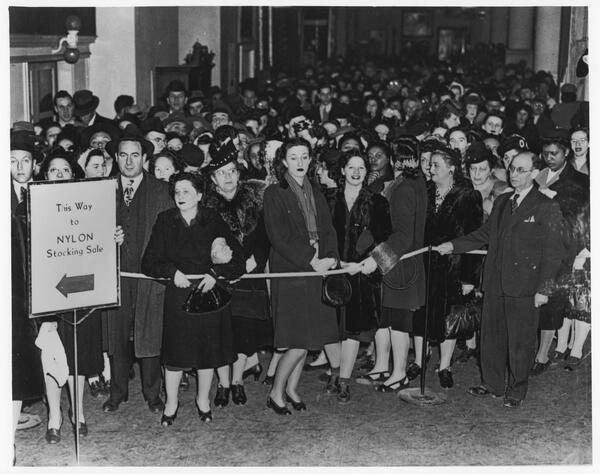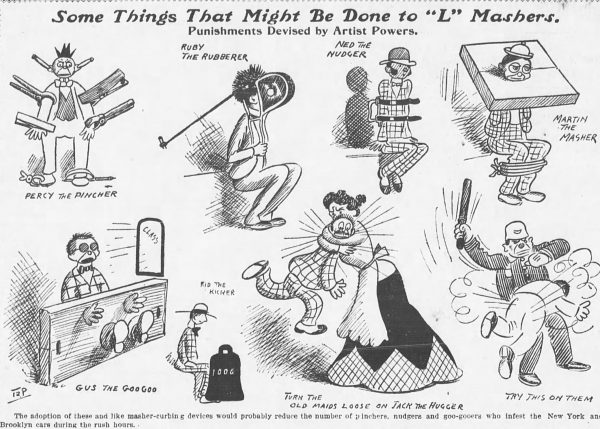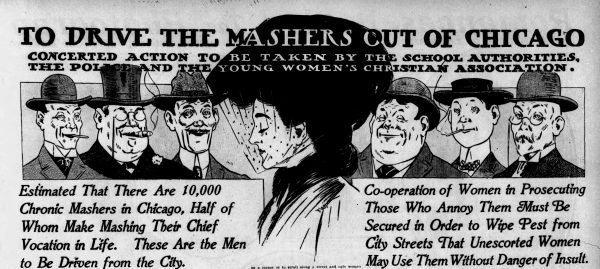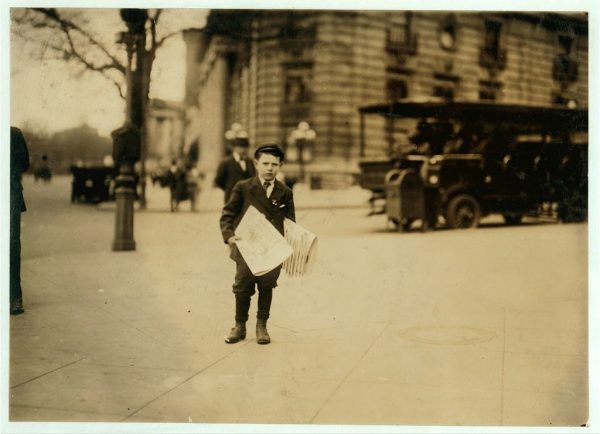Shopping and American Equality: Amplifying on my latest essay

This post went out to subscribers to my Substack newsletter on December 10. Check out all the posts, including ones from the archives not reposted here, and subscribe here.
As the holiday shopping season kicked off, the editors at The Wall Street Journal’s weekend Review section asked if I’d write an essay on Americans and shopping. After picking many brains about the differences between shopping in the U.S. and elsewhere, I ultimately decided to take a different tack: to write about the role shopping has played in defining equality in American life. “Since the mid-19th century, modern retailing has tested the practical meaning of equality and freedom,” I wrote. You can read the full essay here (ungated link).
Space is still limited in the WSJ, which publishes a print edition, so a couple of interesting points wound up on the cutting room floor.
The Dark Side of Policing “Mashers”
As I write in the essay, urban department stores helped to liberate women:
Urban shopping districts were where women claimed the right to dine outside their homes, walk unescorted and take public transportation without loss of reputation. Thousands of female sales clerks flowed out of stores in the evenings, when downtowns had previously been male territory. Department stores provided ladies’ rooms that gave women places to use the toilet and refresh their hair and clothing. They offered female-friendly tearooms. Directly and indirectly, modern shopping enlarged women’s public role.
But as “respectable” women claimed their right to public space, they also attracted unwanted male attention:
It also made sexual harassment a more prominent issue. Men known as “mashers” gathered in shopping districts to ogle and chat up women. Some were no more than well-dressed flirts, violating Victorian norms in ways that few today would find objectionable. Many contented themselves with what an outraged clubwoman termed “merciless glances.” Others followed, catcalled and in some cases fondled women as they strolled between stores, paused to look in windows or waited for trams.

Mores were in flux. By old-fashioned standards, everything from a friendly smile or conversation starter to stalking and groping was an insult to a woman’s virtue. Newspapers launched anti-masher crusades and prominent women demanded stricter law enforcement and stern punishment.
“No other feature of city life offers so many opportunities for making life a burden to the woman who for any reason must go about the city alone or with a woman companion,” opined the Chicago Tribune in 1907, leading a crusade against mashers. Outraged society ladies called for hard labor or public flogging as punishment. “Ogling is just as disgusting and offensive to a good woman as any other mode of attack,” declared the president of the Chicago Women’s Club.
When the Chicago police chief suggested that women avoid harassment by staying home and limiting their time in stores, he was roundly denounced by prominent women, business interests and civic leaders. A clergyman declared it “humiliating…that the authorities responsible for the maintenance of public order should feel themselves compelled to refuse the right of the road to any of the city’s citizens.” Americans increasingly assumed that women deserved the same freedom as men to move about in public—a freedom in which retailers and their suppliers had a large economic stake.
But there’s a darker side to the story that didn’t make it into the essay’s published version. The crusade against mashers, while based on a real problem, had a strong element of moral panic.

In Chicago, where the police chief was soon out of office, police won the power to arrest vagrants, including mashers, without warrants and to seek punishment by hard labor rather than fines. Crusading newspapers didn’t give mashers a chance to defend themselves. Nor did they report on the wrongly accused. In the same era that society women were calling for mashers to be publicly whipped, lynching reached its peak—often sparked by the allegation of masher-type offenses that crossed color lines.
Giving police broad powers to arrest men who made shoppers uncomfortable was an extreme solution. (Many women declined to testify in court, so prosecutions were spotty.) It did help to make streets safer for women, but so did a shift in mores that more clearly distinguished between flirtation and assault.
When polarized media represented the “good old days”

My essay quotes Samuel Strauss, an early critic of what he called “consumptionism” in a touchstone 1924 Atlantic article. That article includes a striking analysis of what Strauss saw as the perverse effects of consumer advertising on the era’s newspapers. Readers, he complained, no longer looked to newspapers to tell them what to think, merely what to buy. Driven by advertising, journalism was no longer sectarian. It sought to represent consensus views.
America’s newspapers used to be, before all else, the expression of the tempers and beliefs which set small groups of citizens apart from one another. Newspapers are coming to be, before all else, instruments for those needs and desires men have most in common. Large communities which formerly had a dozen newspapers are being reduced to two or three newspapers; what logical reason eventually to have even so many as two or three?
Industry did not set out to deprive the nation’s thousand opinions and prejudices of their means of expression. Industry set out to reduce overhead. Industry set out to substitute for the many financially uncertain newspapers a few financially certain newspapers. Small groups of readers, those who happened to feel alike in regard to the tariff or immigration or vivisection, did not efficiently serve the advertiser. The advertiser needed readers to be centralized; he needed the largest possible number of readers divided into the smallest possible number of groups — divided, that is to say, not according to what readers believe, but according to what readers are likely to buy. The advertiser has small interest to know whether the circulation of a newspaper is composed of Republicans or Democrats; but to pursue his advertising efficiently he must know whether the newspaper’s readers buy on the main floor or in the basement.
A half-dozen newspapers, one for each stripe of belief in the community, was good democracy. It was bad business…
Before the advent of television, magazines, too, served general readerships that supported big consumer brands. Local retailers and classified ads supported newspapers. That was the world Strauss decried.
Consumptionism is steadily substituting rich newspapers for poor newspapers, inclusive newspapers for clannish newspapers, forty-page newspapers for eight-page sheets. And what of it?
Is not this all advantage? Is not all that was of value still here? Fourteen editors in one place instead of fourteen editors in fourteen places: what has gone save waste, and inefficiency, and instability, and poverty? Has nothing gone then? Is the freedom of the Press nothing? For it is no less than the freedom of the Press that is going.
Why the freedom of the Press? In order to have a free Press, must we have a financially unstable, inefficient Press? How should it take from the freedom of the Press to have one strong newspaper with room for all prejudices and all preferences, rather than to have many weak ones with room for only one pet abomination and one passionate predilection? Should this make the difference between a newspaper Press with political influence and a newspaper Press with a rapidly diminishing political influence? Perhaps it should not: perhaps there is no logical reason why it should. But that is what it does just the same.
When TV arrived as a more efficient way of selling cars, Coke, and Campbell’s soup, general-interest publications like Collier’s found themselves out of business. Magazines survived only if they could identify and serve narrower audiences. At the very least they separated men and women, business and leisure pursuits—vertical advertising markets. With their local emphasis, daily newspapers remained oriented toward the broadest possible market. So did most TV.
Then the internet arrived. Classifieds disappeared and so local retailers. Department stores consolidate, leaving one or two where there used to be many buying ads. Subscriptions again became the way to profits. Now we’re again living in the media world for which Strauss was nostalgic—the world of “clannish” news that tells people what to think instead of “inclusive” news that only tells them what to buy.